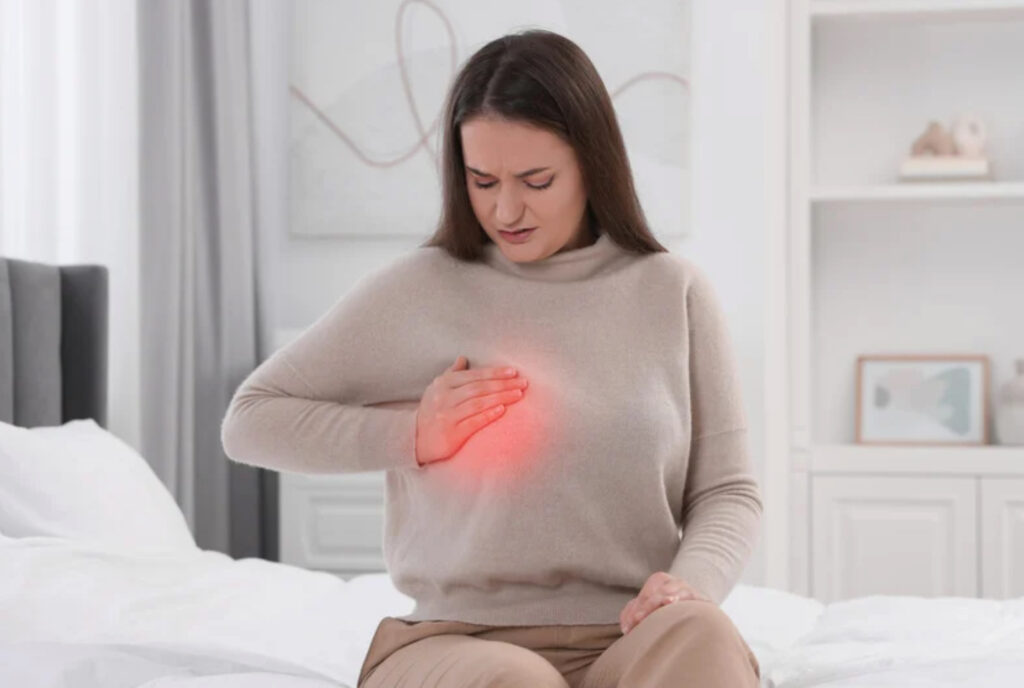What’s normal, what’s not — and why paying attention could save your life.
If you’ve found yourself wincing a little more often when you hug someone or noticing that your favorite bra suddenly feels tighter than usual, you’re not alone. Many women experience new or changing sensations in their breasts during perimenopause — the transitional years leading up to menopause when hormone levels rise and fall unpredictably.
But here’s the truth: while many of these breast changes are normal and tied to hormonal fluctuations, they also serve as an important barometer of your overall hormone health. Your breasts are talking — and it’s time to start listening.

Your Breasts Reflect Your Hormonal Balance
Your breast tissue is incredibly sensitive to hormonal shifts, particularly estrogen and progesterone, the two hormones that orchestrate much of a woman’s reproductive rhythm. During your 20s and 30s, these hormones rise and fall in a fairly predictable pattern. But as perimenopause begins, that rhythm becomes irregular — sometimes estrogen spikes unexpectedly while progesterone quietly declines.
This imbalance can cause a variety of sensations:
- Soreness or tenderness that feels like premenstrual pain
- Temporary swelling or fullness
- Increased sensitivity to touch or pressure
- A lumpier or denser texture
These fluctuations are your body’s way of adjusting to a new hormonal normal. In most cases, these changes are benign — but they’re not something to ignore. They’re messages from your body about how it’s responding to your shifting internal chemistry.
What’s Normal During Perimenopause
Let’s normalize what women often notice during this phase. You might experience:
- Mild tenderness that comes and goes, especially before your period or around ovulation.
- Swelling or heaviness in one or both breasts, usually related to hormonal water retention.
- Cyclical lumpiness, which can make your breasts feel denser at certain times of the month.
- A change in breast size, often temporary and related to hormonal or weight changes.
These are typically signs that your estrogen and progesterone are fluctuating — and your body is responding accordingly.
What’s important is not to panic, but to stay observant. Understanding your unique pattern helps you differentiate between what’s “normal for you” and what might signal something more concerning.
When to Pay Closer Attention
Here’s the other side of the story — some breast changes require attention, even if you suspect they’re hormonal.
Watch for:
- A lump that persists beyond your menstrual cycle.
- Skin changes such as dimpling, puckering, or redness.
- Discharge from the nipple that’s clear, bloody, or occurs without squeezing.
- Persistent pain localized to one area.
- Visible changes in breast size or shape that don’t resolve.

If any of these appear, schedule a clinical breast exam or imaging. Most findings turn out to be benign, but early evaluation is key to peace of mind — and prevention.
Perimenopause: A Window of Awareness
It’s tempting to write off breast tenderness or swelling as “just hormones,” but this phase of life calls for deeper awareness. Perimenopause is a time when the effects of years of stress, diet, toxin exposure, and lifestyle choices start to show up more noticeably.
Your breasts, in particular, can reveal how well your body is processing and metabolizing hormones. Tenderness, fullness, or density changes can be early signs of hormone imbalance — or even impaired estrogen detoxification.
So rather than brushing off your symptoms, think of them as early signals of what your body needs.

Final Thoughts
Your breasts are not just physical — they carry emotional and energetic messages as well. During perimenopause, they remind you to slow down, listen, and take care of yourself more intentionally.
If your breasts feel different lately — tender, fuller, or simply not the same — don’t ignore it. These changes may be normal during perimenopause, but they’re also your body’s way of asking for attention.
Your breasts are sensitive messengers of hormonal balance. Understanding what’s normal versus what needs care helps you respond with awareness instead of worry.
In Part 2, we’ll explore how estrogen dominance and poor hormone metabolism play a major role in breast health — and what you can do to keep your hormones working for you, not against you.
In my upcoming book, I share a simple, step-by-step approach to help you decode your symptoms, support your hormones, and feel like yourself again — naturally and sustainably.
In the meantime, take my FREE Hormone Quiz to discover if you may be experiencing Estrogen Dominance — one of the most common root causes of breast tenderness, swelling, and density changes during perimenopause. Then, if you’re ready to go deeper, schedule your FREE 15-minute consult at ConsultLori.com to map out your next healing step — one that supports your breast health, hormonal balance, and long-term vitality.
Because every woman deserves to understand her body, honor her changes, and feel confident in her journey toward wellness.

